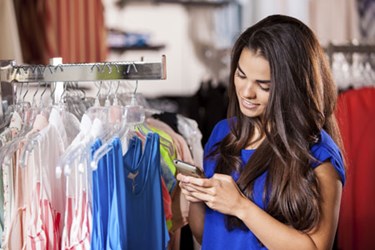 As smartphone adoption and capabilities continue to expand, new innovative marketing techniques are beginning to emerge, including the integration of beacons in retail locations—the cost-friendly, in-store “GPS” network directs each smartphone user to personalized recommendations and notifications inside brick and mortar stores, enhancing the shopping experience and creating growth of in-store traffic and sales.
As smartphone adoption and capabilities continue to expand, new innovative marketing techniques are beginning to emerge, including the integration of beacons in retail locations—the cost-friendly, in-store “GPS” network directs each smartphone user to personalized recommendations and notifications inside brick and mortar stores, enhancing the shopping experience and creating growth of in-store traffic and sales.
The Beacon’s unique technology opens up many store performance opportunities, such as providing a convenient, specialized shopping experience to “click and collect” customers, already having their items waiting at the register. The beacons can sync to customer’s wish lists, taking them to the accurate section of where they will find what they need. With a fully-prepared team of employees that can quickly recognize category-specific customers and offer fast assistance, time will be saved for customers and retailers alike. The beacons also collect useful data of customer interests and behavior, the amount of in-store visits, and tracks device usage.
There is plenty of potential packed into a very affordable beacon network — the cost to implement a series of beacons is astonishingly cost effective — at just $20 and under per beacon, the hardware runs for up to two years on a single coin battery, greatly reducing the overall costs for maintenance. Replacement of old or faulty beacons is comparable to simply replacing a used light bulb.
Beacons connect to customers with iOS 7 and Bluetooth activated devices. Users with iOS7 must be looking at their phone in order to receive messages from the beacons, therefore, retailers must give customers a reason to pull out their phones upon entry of store. In a matter of seconds, the cohesive network sends out valuable messages to each customer, depending on their in-store location. Retailers can even reach out to brand-favoring consumers outside of the store (those that have the brand app downloaded), sending exclusive deals on products that would otherwise be undiscovered without beacon technology, inviting a new wave of customers into stores.
The Bluetooth Low Energy Beacons, being around for only 18 months, is beginning to be discovered by more and more businesses as ways to engage with customers on a personal level—guiding customers directly to what they are looking for. Last December, Apple introduced beacon technology into its Manhattan location, sending out alerts of savings, products, and events taking place at the flagship store. Duane Reade, largest drugstore chain in NYC, installed beacons in ten locations as of early this May. GameStop, leading seller of games, consumer electronics, and wireless services, began adding beacons to their retail locations in early July—with plans to roll out to a total 60 stores by the end of this year. Over half of the top 100 retailers nationwide are testing beacons in stores this year, with one-third to have the beacon network already installed by the end of 2015. The percentage of retailers incorporating beacons into their location is expected to escalate from 8 percent this year to 84 percent by 2016. Estimote, dedicated to developing engaging platforms and operating systems for retailers worldwide, stated, “New data and communication technology can be used to improve customer experience, bringing in new revenue streams for retail stores or cutting their costs. We call it the smart retail.”



Comments are closed.